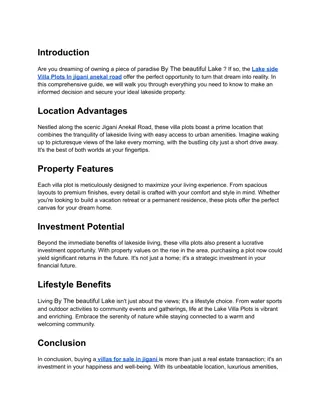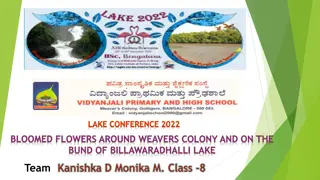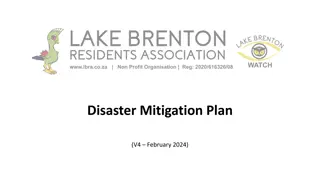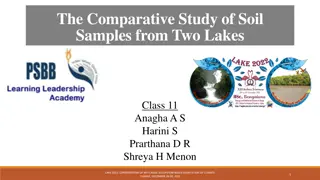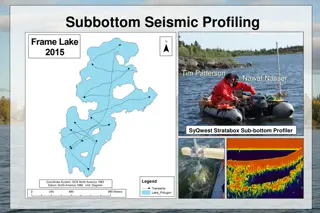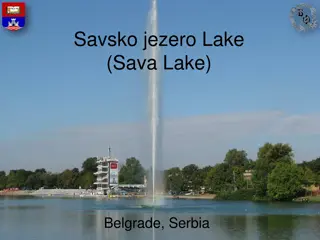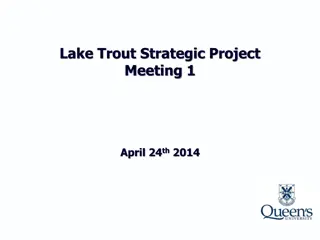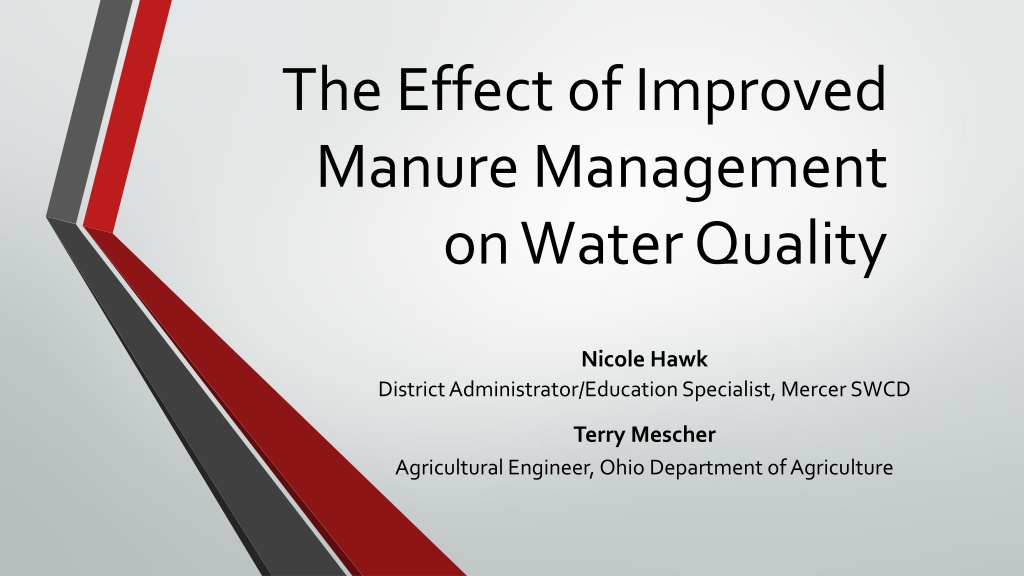
Improved Manure Management for Water Quality Enhancement
This study delves into the impact of enhanced manure management practices on water quality in Grand Lake St. Marys Watershed, Ohio. The region has faced water quality issues due to historic algal blooms, prompting the implementation of Distressed Watershed Rules focusing on livestock facilities and manure application. The rules regulate aspects like manure storage, application timings, and nutrient management planning to mitigate environmental pollution. Producers are required to develop nutrient management plans approved by the Local SWCD and Agriculture Director to ensure sustainable agricultural practices.
Download Presentation

Please find below an Image/Link to download the presentation.
The content on the website is provided AS IS for your information and personal use only. It may not be sold, licensed, or shared on other websites without obtaining consent from the author. Download presentation by click this link. If you encounter any issues during the download, it is possible that the publisher has removed the file from their server.
E N D
Presentation Transcript
The Effect of Improved Manure Management on Water Quality Nicole Hawk District Administrator/Education Specialist, Mercer SWCD Terry Mescher Agricultural Engineer, Ohio Department of Agriculture
Grand Lake St. Marys Located in West-Central Ohio Built in the late 1830 s and early 1840 s Reservoir to supply water to the Miami-Erie Canal
Grand Lake St. Marys Watershed -58,000 acres Lake Area Originally - 17,000 acres Currently - 12,500 acres Lake Characteristics Shallow, 6 8 deep Internal loading Long detention time
Grand Lake Watershed Row crop agricultural area with intensive livestock production Challenges Manure Management Nutrient Management Others
Water Quality Issues History of water quality issues prior to the 1960 s 2010 Historic algal blooms across the entire lake ODNR closes the lake to recreational traffic State of Ohio drafts and implements Distressed Watershed Rules
Distressed Watershed Rules Rule package focused on livestock production facilities and manure application practices within the watershed Rules address 2 primary focus areas Manure Storage & Application Requirements Nutrient Management Planning
Distressed Watershed Rules Manure Application No manure application from Dec 15 through March 1 each year No surface application of manure on frozen or snow covered ground Must incorporate No surface application if weather forecast indicates >50% chance of precipitation exceeding or more All of the setbacks and recommendations in NRCS sNutrient Management Standard (590) are required
Distressed Watershed Rules Nutrient Management Planning Producers must develop a nutrient management plan (currently all producers have developed a CNMP) Plans must be approved by the Local SWCD & by the Director of Agriculture Plans are updated every 3 years Plan requires current soil tests and annual manure analysis Plan must show proper utilization of all phosphorus and nitrogen from both manure and fertilizer
Water Quality Heidelberg University installed monitoring station on Chickasaw Creek in 2008 Water quality and quantity data is collected up to 3 times per day Monitoring data includes: Suspended Solids Nitrate Nitrogen; Total Kjeldahl Nitrogen Particulate Phosphorus; Dissolved Reactive Phosphorus Other
Understanding The Data Pre / Post refers to implementation of Distressed Watershed Rules Flow divides channel flow into 3 equal flow ranges Regulatory period Dec 15 through March 1 Non-Regulatory period March 1 through Dec 15 Nutrient levels given in average concentration for the given flow 80 70 60 50 TSS (mg/L) 40 30 20 10 0 Pre Post Pre Post Pre Post Pre Post Pre Post Pre Post Low Flow Medium Flow High Flow Low Flow Medium Flow High Flow Non-Regulatory Period Regulatory Period
Total Suspended Solids 80 23% 70 Reduction 60 29% Reduction 50 TSS (mg/L) 40 30 20 36% Reduction 10 0 Pre Post Pre Post Pre Post Pre Post Pre Post Pre Post Low Flow Medium Flow High Flow Low Flow Medium Flow High Flow Non-Regulatory Period Regulatory Period
Nitrate 20 32% Reduction 15 16% Reduction 41% NO3- (mg/L) Reduction 10 19% Reduction 5 0 Pre Post Pre Post Pre Post Pre Post Pre Post Pre Post Low Flow Medium Flow High Flow Low Flow Medium Flow High Flow Non-Regulatory Period Regulatory Period
Particulate Phosphorus 0.35 46% 0.30 Reduction 0.25 12% PP (mg/L) 0.20 Reduction 55% Reduction 57% 0.15 Reduction 0.10 0.05 13% Reduction 0.00 Pre Post Pre Post Pre Post Pre Post Pre Post Pre Post Low Flow Medium Flow High Flow Low Flow Medium Flow High Flow Non-Regulatory Period Regulatory Period
Dissolved Reactive Phosphorus 0.275 48% 18% Reduction Reduction 0.250 0.225 28% Reduction 0.200 DRP (mg/L) 0.175 0.150 0.125 0.100 Pre Post Pre Post Pre Post Pre Post Pre Post Pre Post Low Flow Medium Flow High Flow Low Flow Medium Flow High Flow Non-Regulatory Period Regulatory Period
Dissolved Reactive Phosphorus 0.275 44% Increase 0.250 0.225 0.200 DRP (mg/L) 48% 0.175 Reduction 0.150 0.125 0.100 Pre Post Pre Post Pre Post Pre Post Pre Post Pre Post Low Flow Medium Flow High Flow Low Flow Medium Flow High Flow Non-Regulatory Period Regulatory Period
Dissolved Reactive Phosphorus Loading & Timing 0.6 0.5 Moderate 0.4 Moderate Increase Increase DRP (mg/L) Drastic Increase 0.3 0.2 0.1 0.0 Post Post Post Post Post Post Post Post Post Post Post Post Pre Pre Pre Pre Pre Pre Pre Pre Pre Pre Pre Pre Low Flow Medium Flow High Flow Low Flow Medium Flow High Flow Low Flow Medium Flow High Flow Low Flow Medium Flow High Flow GROWING WINTER PRE PLANT HARVEST
In Simpler Terms Total Suspended Solids Reduced approximately 25% Particulate Phosphorus Reduced approximately 26% Soluble Reactive Phosphorus Reduced approximately 3% Nitrate Nitrogen - Reduced approximately 31% Total Kjeldahl Nitrogen - Reduced approximately 26%
Role of the Conservation District Provide voluntary assistance to producers Serve as the primary source of information in the watershed on efforts to improve water quality Use all of the tools in the box to get conservation on the ground Work with producers to be shelf ready for when funding is available to assist with the installation of conservation practices on the farm
Lessons Learned Honesty, Consistency and Communication are key Balance voluntary conservation with regulatory role If it s difficult to discuss, it s important to discuss Build relationship / trust with producers Partnerships are critical - Bring your strengths and connections to the table Agree to Disagree
Take Away Messages Maintain constant communication Schedule regular updates with political and agency officials as well as your critics Don t assume that others know what you have accomplished TELL YOUR STORY! Keep all stakeholders and the public up-to-date on successes and challenges Utilize traditional and social media Highlight conservation efforts to other watersheds
Questions nicole.hawk@mercercountyohio.org terry.mescher@agri.ohio.gov









